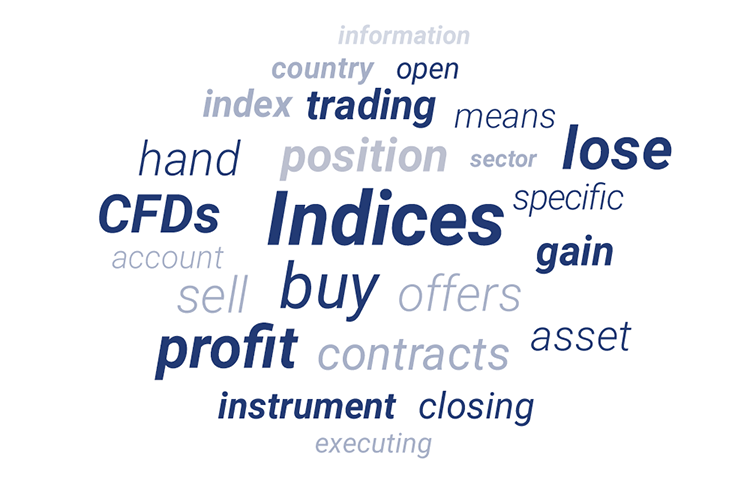How to Trade Indices
Trading indices allows traders to get more exposure to the market by tracking more than one individual stock. But how do you exactly trade indices?
In this article, we are going to cover index trading methods and discuss the factors to look for when picking an index.
Trading Index Futures
Plus500 offers CFD traders the option to trade future contracts on some of the most popular indices. CFDs on futures allow individuals to place Buy and Sell orders depending on whether they believe that an index will gain or lose in value. While there are many positive features to trading index futures contracts, one must be mindful of the risks associated with this form of trading due to the unpredictable price fluctuations that can occur. It must also be noted that while you can gain more money than your initial margin when trading index futures, you can also incur more losses if a trade goes against your position. Thus, in order to execute an index CFD trade, a trader must consider their position.
There are two positions possible:
- Buy - Executing a ‘Buy’ order means that you believe the instrument will increase in value. If the price of the instrument does indeed climb and you close your position, your profit is the difference between your ‘buy’ price and the closing price. On the other hand, if you close your position at a price that is lower than your ‘buy’ price, then your loss is the difference between your ‘buy’ and close price.
- Sell - Executing a ‘Sell’ order means that you believe the instrument will decrease in value. If the price of the instrument does indeed drop and you close your position, your profit is the difference between your ‘sell’ price and the closing price. On the other hand, if you close your position at a price that is higher than your ‘sell’ price, then your loss is the difference between your ‘sell’ and close price.
Plus500 offers traders an opportunity to trade based on the value of these contracts, in the form of Contracts For Difference (CFD) instruments.

Trading Index CFDs with Plus500
When you are ready to trade CFDs on Indices with Plus500, you can open the instrument and view the relevant instrument information such as charts, spread information, rollover details, and more. You can also use Plus500’s free demo account until you feel confident to trade using real money.
Choose whether to open a ‘buy’ order if you believe the index will rise or a ‘sell’ order if you believe it will fall. Trading CFDs means you are not buying or selling the underlying asset but rather you are opening a contract on which direction you predict the market will move.
The Plus500 platform offers some trader-focused features to help you manage your trades. Some examples include an option to ‘close at profit’ which will automatically close your position at a specific level set by you in order to protect your profit, and ‘close at loss’ if you want to set a limit for the amount you are willing to lose.The ’close at profit’ and ‘close at loss’ features are free of charge, and do not guarantee your position will close at the exact price level you have specified.
What to Consider When Picking an Index
Bountiful market indices also mean that picking an index to follow can often be a challenging task, and since indices are unique trading tools because their value fluctuations are directly influenced by the rise and fall of other instruments, there are factors that traders should take into account when picking an index to follow. Accordingly, just as traders research the fluctuations and factors for shares or commodities, it is important to weigh all the factors that may move an index in either direction, including various companies and sectors.
Here are some of the aspects that should be considered when choosing an index:
- Its comprehensiveness: when choosing an index, it is important to consider which market segments and moves it covers. The more an index accurately represents its target market sectors without omitting certain securities, the more it is reliable and valid. Therefore, traders should look for indices that cover most of their intended sectors for a more profitable fit.
- Up-to-date and maintained: it is wise to look for regularly-scheduled and balanced indices, especially due to the market’s volatile and versatile nature. This is why it is important to choose indices that follow and reflect recent price movements so that they would be as precise as possible.
- Unbiased and transparent: when picking an index, one should be mindful of its transparency and objectivity. There are objective indices and committee-based ones. While the former allows traders to understand the market moves, the latter is subjective, and thus, can often be misleading.
- Low index funds and ETFs: when looking for an index opt for indices with low Index prices or ETFs. This is because in an index you don’t get to see which particular instruments you are paying more fees on, so looking at lower-priced indices allows you to save money.
Finally, when choosing an index one must note that multiple factors can affect its performance. Factors that can affect indices include, but are not limited to, political events, traders sentiment, and unemployment reports. These are events that may move an Index in a specific direction, so even if the biggest company in the Index sees a big jump, the index value as a whole may drop due to the movements of the other companies included in the Index.
*Product offering is subject to operator.